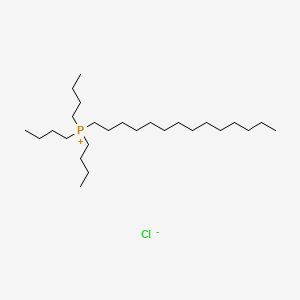D1133 | tributyltetradecylphosphonium chloride
| Toxicity | Dose | Time | Species | Model | Method | Action | Positive criterion | Reference |
|---|---|---|---|---|---|---|---|---|
| MEMBRANE POTENTIAL | 0.71±0.15 | human | qHTS-HepG2 | MMP assay | decrease | IC50 | 163 | |
| MEMBRANE POTENTIAL | 1.12 | human | HepG2 | MMP assay | decrease | IC50 | 163 | |
| MEMBRANE POTENTIAL | 7.66±0.50 | rat | hepatocytes | MMP assay | decrease | IC50 | 163 | |
| Pictogram | Signal | Statements | Precautionary Statement Codes |
|---|---|---|---|
    |
Danger |
Aggregated GHS information provided by 78 companies from 6 notifications to the ECHA C&L Inventory. Each notification may be associated with multiple companies. H302 (100%): Harmful if swallowed [Warning Acute toxicity, oral] H314 (100%): Causes severe skin burns and eye damage [Danger Skin corrosion/irritation] H318 (43.59%): Causes serious eye damage [Danger Serious eye damage/eye irritation] H330 (51.28%): Fatal if inhaled [Danger Acute toxicity, inhalation] H400 (50%): Very toxic to aquatic life [Warning Hazardous to the aquatic environment, acute hazard] H410 (51.28%): Very toxic to aquatic life with long lasting effects [Warning Hazardous to the aquatic environment, long-term hazard] Information may vary between notifications depending on impurities, additives, and other factors. The percentage value in parenthesis indicates the notified classification ratio from companies that provide hazard codes. Only hazard codes with percentage values above 10% are shown. |
P260, P264, P270, P271, P273, P280, P284, P301+P312, P301+P330+P331, P303+P361+P353, P304+P340, P305+P351+P338, P310, P320, P321, P330, P363, P391, P403+P233, P405, and P501; (The corresponding statement to each P-code can be found at the GHS Classification page.) |
   |
Danger |
H302: Harmful if swallowed [Warning Acute toxicity, oral] H311: Toxic in contact with skin [Danger Acute toxicity, dermal] H314: Causes severe skin burns and eye damage [Danger Skin corrosion/irritation] H330: Fatal if inhaled [Danger Acute toxicity, inhalation] |
P260, P264, P270, P271, P280, P284, P301+P312, P301+P330+P331, P302+P352, P303+P361+P353, P304+P340, P305+P351+P338, P310, P312, P320, P321, P322, P330, P361, P363, P403+P233, P405, and P501; (The corresponding statement to each P-code can be found at the GHS Classification page.) |
| (Tri-n-Butyl)-n-Tetradecylphosphonium Chloride | 81741-28-8 | 82832Q4G52 |
| AK163584 | AKOS015833154 | CAS-81741-28-8 |
| CHEMBL3183454 | CTK3E8857 | Caswell No. 866A |
| DSSTox_CID_14997 | DSSTox_GSID_34997 | DSSTox_RID_79234 |
| DTXSID9034997 | EINECS 279-808-2 | EPA Pesticide Chemical Code 128824 |
| F0001-2100; | FT-0688175 | KS-000000ZH |
| NCGC00257372-01 | NCGC00259558-01 | Phosphonium, tributyltetradecyl-, chloride |
| Q27269315 | RTR-025657 | SCHEMBL358875 |
| ST24050250 | TR-025657 | TRA0043101 |
| Tetradecyltributylphosphonium chloride | Tox21_202009 | Tox21_303556 |
| Tri-N-butyl tetradecyl phosphonium chloride | Tri-N-butyltetradecylphosphonium chloride | Tributyl tetradecyl phosphonium chloride |
| Tributyl(tetradecyl)phosphonium chloride | Tributyltetradecylphosphonium chloride | UNII-82832Q4G52 |
| W-111555 | tributyl(tetradecyl)phosphanium;chloride |
| CAS Number | 59833-69-1, 81741-28-8 |
| PubChem Compound | 9889168 |

